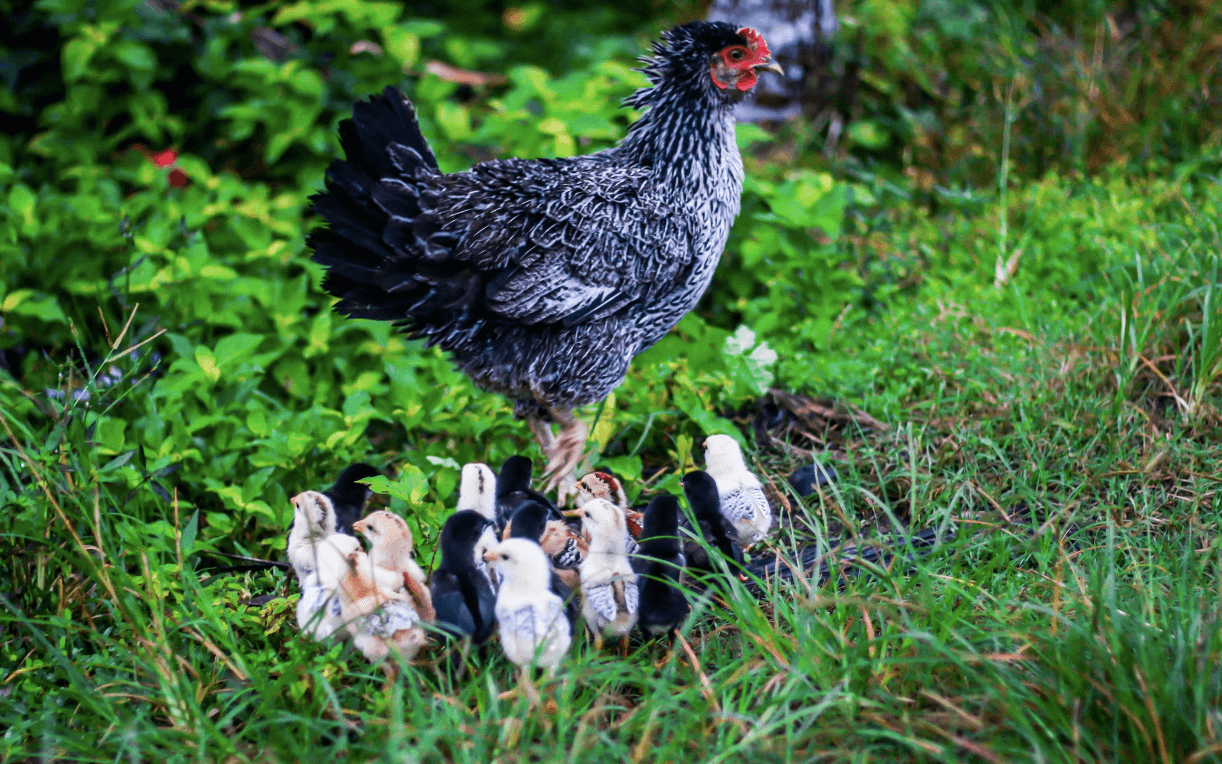If you’re ruminating on questions such as “Why did the chicken cross the road?", or “Can chickens fly?” you may be in for humor, or you may be in for inquisitiveness of mind and encyclopedic tendencies. If you’re a poultryman, however, you’re in for nothing other than practical reasons, okay that and the fact you want to know more awesome facts about chickens—but it’s practicality by and large.
As a novice in the chicken-rearing business, you may think, what can possibly go wrong when your chickens are safely cooped up in their runs and their nest boxes? Oh, but it can. There’s a real-life possibility of your chickens getting spooked by a predator so they fly over the fence, leaving nasty surprises outside the cozy confines of their coop.
Or you can have the worst-case scenario of your chickens escaping into the neighboring yard landing on your neighbors’ well-tended turf and deck railings. You can have them trespassing into your fenced vegetable garden or even more dramatically be exposed to the ever-looming threats of dangerous predators.
Speaking from the chicken connoisseur's perspective, whichever the case, you’ll need an insider tip or two on how to stop chickens from flying over fences and keep them out of trouble.
How High Can Chickens Fly?
Every chicken is different, and this varies by breed immensely, but a rough estimate is that chickens can fly as high as about 10 feet. Chickens are not exactly brilliant flyers when it comes to how much distance they can traverse flying too. A record duration of a chicken flight is no more than 13 seconds covering a distance of not more than three hundred feet.
That’s about outstanding chickens; you can expect your home run-of-the-mill backyard chickens to normally fly for forty or fifty feet.
That doesn’t sound like much but that’s just about enough for a bird to get in trouble with predators, neighboring dogs, OR your neighbors, or to be left at the mercy of busy roads.
Why Do Chickens Have Wings If They Can't Fly?
But wait, what terms are we operating with, can or cannot chickens fly? In the previous section we’ve mentioned they can reach a height of roughly 10 feet, and in this title, we negate their ability to fly. So, what’s the catch? It’s a matter of degree rather than it is an either-or situation.
Short and sweet, chickens (Gallus gallus domesticus) are domesticated animals and their domestication has had a major impact on their flying aptitudes. Let’s explain this in more detail.
The jungle fowl (Gallus gallus) from which modern chickens descended can fly, but only for short distances. This bird has strong and powerful muscles, but it lacks stamina, so it can only fly short distances.
But how do chickens account for their lack of flying performance? As mentioned, chickens can barely fly because they were bred for food being made to develop larger flight muscles and shorter wings. This plays into the so-called appropriate "wing loading"—a ratio of body mass to wing area. To fly, chickens must hit the sweet spot of this ratio, and since they don't, this accounts for their poor flying performance.
Will Chickens Fly Over a 6-Foot Fence?
Chickens are not too enthusiastic about leaving their well-known safe territory. They’re unlikely to fly over a much shorter 3-foot fence. However, if properly motivated, most breeds, even heavy breeds, CAN fly over a 6-foot fence.
That said, you shouldn’t expect your feathered friends to leave their enclosure unless they get startled by predators, roosters, or other chickens. This gets to be the number one reason chickens fly over fences in the first place.
And since you never know with your more adventurous two-legged winged friends, you’ll want to avoid any unwanted incidents, which brings us to the next section.
How to Keep/Stop Chickens from Flying & Jumping Over Fences?
There are a few simple ways to stop your chickens from flying or jumping over fences. These include providing healthy nurturing conditions, installing higher perches, adding roofs to your coops, etc.
Most of the time, however, you won’t have to take any dramatic action as chickens tend to instinctively return to the coop at dusk. Catching your fowl daytime roosting in tree branches is nothing too alarming if they’re contained within your property. Getting out of your property is where the problem begins.
That said, below are a few insider tips on how to prevent your chickens from fleeing their enclosure, getting caught by predators, or experiencing other more or less predictable chicken incidents.
Get Higher Perches
When dealing with jumping chickens, providing higher perches as a prevention measure is a good idea. The thing is, birds will normally seek higher perches to roost at night which makes them vulnerable to nocturnal predators. Providing higher perches within the coop will lower their risk of them getting snatched at night.
Limit Opportunity
You never know when you might have an odd chicken take flight and run wild around the neighborhood. That's why it’s better to limit any opportunity of your chickens “fleeing their nest” in advance.
Chickens are more active during the day, but it’s actually during the night that you’ll have to pay more attention to avoiding any unwanted flying incidents. Chickens will normally retreat to their coop at dusk, but if your chickens aren’t trained to do so, this can lead to some of them getting lost and jumping over fences unnoticed. That’s why it’s wise to lock your birds at night time in their coops.
Keep the Birds Fed and Entertained
As mentioned before, your chickens will leave your property parameters only if properly motivated. That’s why in the whole business of keeping the birds from escaping your grounds, keeping them happy and full is half the job done.
That said, incentivize your birds by feeding them well. Keep them content by providing ample space, and keeping them warm and clean. Consider installing chicken coop heaters (a necessity in colder climates), or adding poop trays (a necessity or luxury, but that rather depends on your personal views).
No less importantly, make sure to add in some fun. A swing to perch on is a good addition to your coop. Also, put in a simple bale of hay in your chicken run; this allows your birds to play to their heart’s content. In effect, jumping over fences won’t be nearly as appealing.
Clip Their Wings
Another way to keep your chickens from flying over the fence is to clip their wings. Clipping your chickens’ wings will prevent them from flying, jumping, and escaping your property. Mind that wing clipping is not harmful to your birds but it should be done with special care and only when the occasional flight problem starts affecting the safety of your flock.
Clipping only one wing by trimming away just a couple of inches from the tips of the largest primary feathers will suffice to prevent unwanted bird escapades. Bear in mind, however, that flying is your bird's only innate defense mechanism from lurking predators, so clip their wings only if you must.
Get a Coop With an Enclosed Roof
It’s a good idea to have roofing on your chicken coop as an added precaution against both wayward birds and predators. Bird netting will prevent your chickens from taking flight, but if climbing predators such as foxes are a common occurrence in your yard, wire mesh is a necessity.
Most of all, having a sturdy, secure coop is second to none when it comes to your birds’ safety. The Chicken Coop Company designs high-quality chicken coops for sale with the well-being of your domestic fowl in mind. Rearing our own birds, we get very protective when predators plot to snatch them from us, so we strive to be competitive in regards to protection and sturdiness in particular.
Learn more about our quality chicken coop construction and how we secure our coops for the best chicken protection.
Now, onto a fence-related topic, how high should it be? As a rule of thumb, you’d want to keep it over 4 feet, as this height is no obstacle to predators. Still, this depends on the chicken breeds you intend to keep. Large, docile dual-purpose breeds won’t get particularly adventurous.
But let us tell you, backyard breeds like bantams, Leghorns, Hamburgs, or others like Andalusians, or Penedesencas are great flyers. With that in mind, if you want these breeds in your yard, you’d want to add some height to your fence.
You may also want to consider this if you notice any unusual flying activity inside your flock. The thing is, most breeds will take up flight in a particular development stage. Even the most docile, heavy breeds go through a stage when they have reached their full wingspan, but not their full weight. That’s when they’re able to fly to higher heights and when they're likely to leave their confines.
Concerned about the danger lurking from down below? Consider adding a Predator Proof Wire Mesh Protection Kit to your chicken coop.
The Bottom Line
So, chickens are sloppy flyers but they can fly high enough to get themselves in trouble with large dogs and a busy street on the other side of your fence. They can fly enough to mess up your relationships with your neighbors. Keeping them contained within your property is just a better way of doing things.
The secret is to keep your chickens fed and entertained, safe and tended to, and odds are you won’t find them out of the confines of their coop and run, or your yard, for that matter.
The Chicken Coop Company is a bunch of long-standing poultry people, hammering away at chicken coop construction, finding better ways to keep your chickens happy and contained. Browse our chicken coop kits for sale and see what we have come up with. Or see what others say about us.





